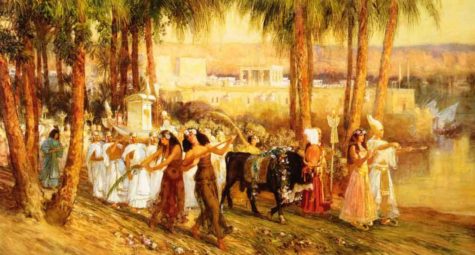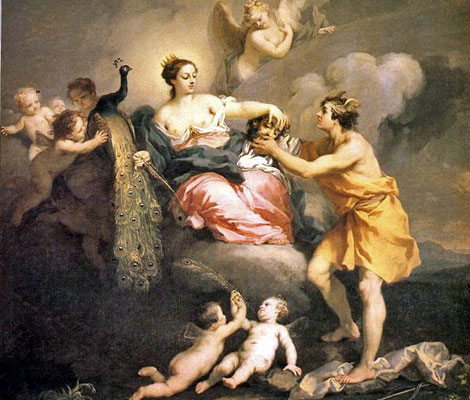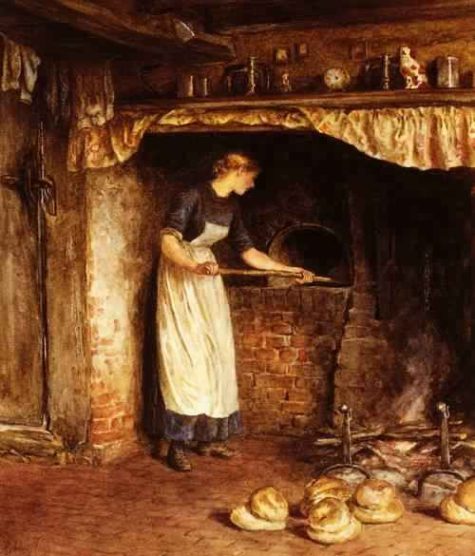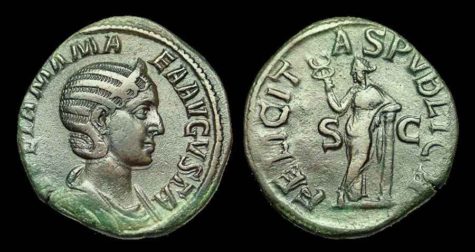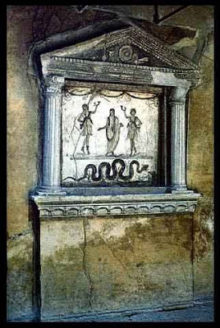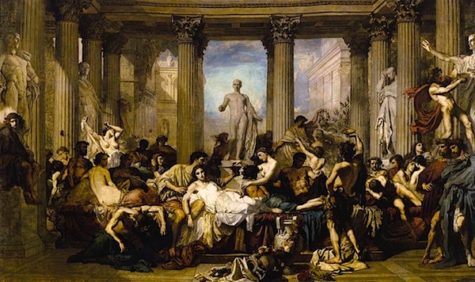Roman Festivals
When Egypt became part of the Roman Empire, Greek merchants brought the worship of Isis from Alexandria to Rome and invoked Her as inventor of the sail, patron of navigation, and ruler of the waves.
Possibly the most well known Isiac festival of the Roman world was the Navigium Isidis, celebrated on the 5th of March. As part of the festivities, a a festive carnival procession was performed in honor of Isis, and the Vessel of Isis, laden with offerings of precious spices and milk libations, is launched.
Here is a colorful and detailed eye-witness account of the procession and the ceremony:
Soon the sun of gold arose and sent the clouds of thick night flying; and lo, a crowd of people replenished the streets, filing in triumphal religious procession. It seemed to me that the whole world, independent of my own high spirits, was happy. The dusky clouds were routed; and the heavens shone with clear sheer splendor of their native light.
Presently the vanguard of the grand procession came in view. It was composed of a number of people in fancy dress of their own choosing; a man wearing a soldier’s sword-belt; another dressed as a huntsman, a thick cloak caught up to his waist with hunting knife and javelin; another who wore gilt sandals, a wig, a silk dress and expensive jewelry and pretended to be a woman.
Then a man with heavy boots, shield, helmet and sword, looking as though he had walked straight out of the gladiators’ school; a pretended magistrate with purple robe and rods of office; a philosopher with cloak, staff, clogs and billy-goat beard; a bird catcher, carrying lime and a long reed; a fisherman with another long reed and a fish hook.
Oh, yes, and a tame she-bear, dressed like a woman, carried in a sedan chair; and an ape in a straw hat and a saffron-coloured Phrygian cloak with a gold cup grasped in its paws – a caricature of Jupiter’s beautiful cup-bearer Ganymede.
Finally an ass with wings glued to its shoulders and a doddering old man seated on its rump; you would have laughed like anything at that pair, supposed to be Pegasus and Bellerophon. These fancy-dress comedians kept running in and out of the crowd, and behind them came the procession proper.
At the head walked women crowned with flowers, who pulled more flowers out of the folds of their beautiful white dresses and scattered them along the road; their joy in the Saviouress appeared in every gesture.
Next came women with polished mirrors tied to the backs of their heads, which gave all who followed them the illusion of coming to meet the Goddess, rather than marching before her.
Next, a party of women with ivory combs in their hands who made a pantomime of combing the Goddess’s royal hair, and another party with bottles of perfume who sprinkled the road with balsam and other precious perfumes; and behind these a mixed company of women and men who addressed the Goddess as “Daughter of the Stars” and propitiated her by carrying every sort of light – lamps, torches, wax-candles and so forth.
Next came musicians with pipes and flutes, followed by a party of carefully chosen choir-boys singing a hymn in which an inspired poet had explained the origin of the procession.
The temple pipers of the great god Serapis were there too, playing their religious anthem on pipes with slanting mouth-pieces and tubes curving around their right ears; also a number of beadles and whiffers crying: “Make way there, way for the Goddess!”
Then followed a great crowd of the Goddess’s initiates, men and women of all classes and every age, their pure white linen clothes shining brightly. The women wore their hair tied up in glossy coils under gauze head-dresses; the men’s heads were completely shaven, representing the Goddess’s bright earthly stars, and they carried rattles of brass, silver and even gold, which kept up a shrill and ceaseless tinkling.
The leading priests, also clothed in white linen drawn tight across their breasts and hanging down to their feet, carried the oracular emblems of the deity. The High Priest held a bright lamp, which was not at all like the lamps we use at night banquets; it was a golden boat-shaped affair with a tall tongue of flame mounting from a hole in the centre.
The second priest held an auxiliaria, or sacrificial pot, in each of his hands – the name refers to the Goddess’s providence in helping her devotees. The third priest carried a miniature palm-tree with gold leaves, also the serpent wand of Mercury. The fourth carried the model of a left hand with the fingers stretched out, which is an emblem of justice because the left hand, with its natural slowness and lack of any craft or subtlety, seems more impartial than the right. He also held a golden vessel, rounded in the shape of a woman’s breast, from the nipple of which a thin stream of milk fell to the ground. The fifth carried a winnowing fan woven with golden rods, not osiers. Then came a man, not one of the five, carrying a wine-jar.
Next in the procession followed those deities that deigned to walk on human feet. Here was the frightening messenger of the gods of Heaven, and of the gods of the dead: Anubis with a face black on one side, golden on the other, walking erect and holding his herald’s wand in one hand, and in the other a green palm branch. Behind, danced a man carrying on his shoulders, seated upright, the statue of a cow, representing the Goddess as the fruitful Mother of us all.
Then along came a priest with a box containing the secret implements of her wonderful cult. Another fortunate priest had an ancient emblem of her godhead hidden in the lap of his robe; this was not make in the shape of any beast, wild or tame, or any bird or human being, but the exquisite beauty of its workmanship no less than the originality of its design called for admiration and awe.
It was a symbol of the sublime and ineffable mysteries of the Goddess, which are never to be divulged a small vessel of burnished gold, upon which Egyptian hieroglyphics were thickly crowded with a rounded bottom, a long spout, and a generously curving handle along which sprawled an asp, raising his head and displaying its scaly, wrinkled, puffed-out throat…
Meanwhile the pageant moved slowly on and we approached the sea shore… There the divine emblems were arranged in due order and there with solemn prayers the chaste lipped priest consecrated and dedicated to the Goddess a beautifully built ship, with Egyptian hieroglyphics painted over the entire hull; but first he carefully purified it with a lighted torch, an egg and sulphur. The sail was shining white linen, inscribed in large letters with the prayer for the Goddess’s protection of shipping during the new sailing season.
The long fir mast with its shining head was now stepped, and we admired the gilded prow shaped like the neck of Isis’s sacred goose, and the long, highly-polished keel cut from a solid trunk of citrus-wood. Then all present, both priesthood and laity, began zealously stowing aboard winnowing-fans heaped with aromatics and other votive offerings and poured an abundant stream of milk into the sea as a libation.
When the ship was loaded with generous gifts and prayers for good fortune, they cut the anchor cables and she slipped across the bay with a serene breeze behind her that seemed to have sprung up for her sake alone. When she stood so far out to sea that we could no longer keep her in view, the priests took up the sacred emblems again and started happily back towards the temple, in the same orderly procession as before.
On our arrival the High Priest and the priests who carried the oracular emblems were admitted into the Goddess’s sanctuary with other initiates and restored them to their proper places. Then one of them, known as the Doctor of Divinity, presided at the gate of the sanctuary over a meeting of the Shrine-bearers, as the highest order of the priests of Isis are called. He went up into a high pulpit with a book and read out a Latin blessing upon “our liege lord, the Emperor, and upon the Senate, and upon the Order of Knights, and upon the Commons of Rome, and upon all sailors and all ships who owe obedience to the aforesaid powers.”
Then he uttered the traditional Greek formula, “Ploeaphesia”, meaning that vessels were now permitted to sail, to which the people responded with a great cheer and dispersed happily to their homes, taking all kinds of decorations with them; such as olive boughs, scent shrubs and garlands of flowers, but first kissing the feet of a silver statue of the Goddess that stood on the temple steps.
From: The Golden Ass
In ancient Roman religion, the Matronalia (or Matronales Feriae) was a festival celebrating Juno Lucina, the goddess of childbirth (“Juno who brings children into the light”), and of motherhood (mater is “mother” in Latin) and women in general. In the original Roman calendar traditionally thought to have been established by Romulus, it was the first day of the year. As the first day of March (Martius), the month of Mars, it was also the Feriae Martis.
The date of the festival was associated with the dedication of a temple to Juno Lucina on the Esquiline Hill circa 268 BCE, and possibly also a commemoration of the peace between the Romans and the Sabines. On the day, women would participate in rituals at the temple, although the details have not been preserved other than the observation that they wore their hair loose (when Roman decorum otherwise required them to wear it up), and were not allowed to wear belts or to knot their clothing in any place.
At home, women received gifts from their husbands and daughters, and Roman husbands were expected to offer prayers for their wives. Women were also expected to prepare a meal for the household slaves (who were given the day off work), as Roman men did at the Saturnalia.
Patti Wigington at Paganwiccan.about.com wrote this nice little description about Matronalia.
This annual “festival of women” was held in honor of Juno Luciana, a goddess who watched over married women and those in childbirth. This aspect of Juno was associated with childbirth. The name lucina was thought to have come from the Latin word lux (light); thus, when a child was born it was said to have been “brought to light”.
In this aspect the goddess was a lunar deity, often paired with Diana and depicted as holding a torch. In the worship of Juno Lucina, women untied knots and unplaited their hair – sympathetic magic to prevent entanglements in the delivery of babies. She was in charge of newborn infants, and a woman in labor might make offerings to her so that she would have a safe delivery of a healthy child.
Women and girls prayed to her and brought offerings for prosperity in marriage. Gifts were exchanged, people feasted on similla, cakes decorated it with 12 balls of marzipan around the edges. and everyone treated the ladies exceptionally well on this day. Cakes with a similar name, simnel cakes, are associated with Mothering Sunday in England from which Mothers’ Day is derived.
Children of all ages were expected to pay a formal visit to their mothers and to bring a Simnel cake as a gift. In return, the mothers gave their children a special blessing. This custom was so well-established that masters were required to give servants enough time off to visit out-of-town mothers – provided the trip did not exceed 5 days!
Juno was the Roman Mother Goddess, known to the Greeks as Hera, and her original name to the Romans was Junonius. Juno is a counterpart of Janus and the divine watcher over the female sex, so this month is considered the best time to marry. As Juno Moneta, guardian of wealth and money, she had a temple on the Capitoline hill in Rome where the empire’s coins were minted.
Among Juno’s attributes, she is queen of heaven, approximating Frigg in the Northern Tradition, and Mary in the Christian. She is ruler of the high point of year, when there is maximum light and minimum darkness (the northern Summer Solstice).
Later on, Matronalia evolved into Mother’s Day in Europe, and was shifted to the fourth Sunday of Lent. During the Middle Ages, those who had moved away from home would return on this day to their “mother” church, visiting their families who still remained in the village. Servants were allowed to pick flowers from their masters’ gardens, and given the day off to return home; hence, the custom of bringing one’s mother some flowers on Mother’s Day.
In the United States, Mother’s Day actually falls in May, and is held in honor of humanitarian work carried out by women during the Civil War.
The Fornacalia, a festival in honor of Fornax, the goddess of furnaces, was held in order that bread might be properly baked, and to bless the ovens used to dry grain. This festival was movable, and could have been held any time between Febuary 5th to February 17th.
Each year the Curio Maximus (a citizen charged with ensuring the observance of curial religious feasts) would announce the date of the Fornacalia and post a separate notice for each curia (neighborhood) in the Forum, probably indicating where each curia should gather for the final part of the celebration.
It is believed that every family in the curia brought far, that is, spelt (a kind of grain), to be toasted in the meeting hall and sacrificed to ensure that bread in the household ovens wouldn’t be burnt in the coming year. Then the curiae assembled for a collective feast.
If on the last day of the Fornacalia (17th of February) anyone had missed the feast or was not a member of a curia (or had forgotten which one he belonged to), he could make a private sacrifice at the general assembly of all the curiae called the Quirinalia. It is believed by some, that because of this the Romans called the Quirinalia the Stultorum feriae, the ‘Feast of Fools.’
To Do Today:
The Fornacalia was a festival of ovens, in which Fornax was invoked by baking wheat breads and other grain-related foods. So think about dusting off your cookbooks, especially any recipes from your family, and start baking! Even people pressed for time can usually make a bath of bread from frozen dough.
If you only own a microwave, have no fear – microwaveable soft-dough pretzels are readily available in the freezer section of your supermarket. Or, simpler still, have toast for breakfast this morning to internalize Fornax’s warm emotions. On the other hand, if you’d like to give Fornax a much needed break from her toils at your place, go out and eat! Just make sure to have some bread as part of your meal to welcome Fornax to your feast.
Finally, take any dried bread you have and crumble it up for the birds. Focus on your desire for love and closeness in your life. The birds will convey your wishes to Fornax, the heavens, and the four corners of creation.
A Ritual For Today
- Color: Brown
- Element: Fire
- Offerings: Give some of the loaves of bread to those who have need of it.
- Daily Meal: Everything baked – breads, cakes, pies, casseroles.
This ritual should be performed in the kitchen, with the altar built on top of the stove or inside the oven. Set a brown cloth with a red candle and many loaves of bread on wooden trays.
Invocation to Fornax
Goddess of the Oven
Lady of Fire Enclosed,
Sacred Baker of our food,
We all started as dough,
Raw and soft and unformed,
And we were patted into shape
By those who raised us,
Yet we could not bring ourselves
Fully grown to the table
Until we had endured
The hardening flame.
Be kind to us, Lady!
As we go through life
Let us not be scorched
Or spared the fire
But bring us gently through
To be our final selves.
Chant:
Baker of the Loaf of Earth
We endure your fire
(One of the loaves is broken and handed around and shared, some more are set aside to eat later, and then the rest are taken to some deserving place and donated.)
- Ritual from: Pagan Book of Hours.org
- Other information collected from various sources
Called Feriae Sementivae, this one or two day Roman festival was moveable, but generally began between January 24 and January 26. Sacred to Tellus, and Ceres, this festival was for the protection of seeds, either those sown the previous fall, or those to be sown in the spring. During Sementivae plowing oxen were decorated with garlands, and puppets or masks were hung from tree branches.
This is an excellent time to begin to think about planting a “Witch’s Garden” and to do spellwork involving seeds. Spiritually and metaphysically, this is an optimum time to sow the internal seeds of what we hope to bring forth as the year unfolds.
January 17 is an excellent day for all magickal workings having to do with luck, success, and money.
It is the feast day of Fausta Felicitas, an ancient Roman Goddess of Good Fortune and Lucky Happenstance. Her name is essentially two words of the same meaning, likely doubled up for emphasis, for fausta in the Latin is the adjective “favorable” or “auspicious”, while felicitas is the noun meaning “luck”, “good fortune” or “happiness”; Her name can be translated as the nicely redundant “Lucky Luck”, though “She of Auspicious Good Fortune” probably sounds better.
By the way, the Latin felix, “happy”, and felis “cat” are related, through the theme of “fruitfulness”, as cats have many young; I’m tempted, however, to interpret the connection as referring to purring, an obvious and defining feature of happy cats.
Her name evokes the Latin saying “Quod bonum faustum felix fortunatumque sit!”, which translates as “May it be good, lucky, happy, and blessed!” According to Cicero (who lived 106-43 BCE), this phrase had been used since ancient times as the proper ritual formula said at the beginning of all kinds of projects or events to assure an auspicious outcome — for example, when cities or colonies were founded, at public rites, at the opening of festivals, or at sacrifices.
Images of this Goddess are found most often on Roman coins.
When casting the spells, the addition of the Latin saying “Quod bonum faustum felix fortunatumque sit!” as well as invoking the power of the Goddess herself would seem to ensure an even more successful outcome.
Found at The Obscure Goddess Online Directory
The Roman Goddess Concordia is honored and feasted on many different days throughout the year. She is the Goddess of Harmony and Good Relations, and her presence at any grand festival was likely required.
According to some calendars, January 16 is listed as the Festival of Concordia. I could not find much more about this particular day. I would assume that any festival involving this Goddess would or could include the following:
- Forgiveness
- Olive branches
- Coming together to work out differences
- Harmony – maybe even singing in harmony
- Sufi dances of Universal Peace might also be appropriate
In Italian folklore, Befana is an old woman who delivers gifts to children throughout Italy on Epiphany Eve (the night of January 5) in a similar way to St Nicholas or Santa Claus.
In popular folklore Befana visits all the children of Italy on the eve of the Feast of the Epiphany to fill their socks with candy and presents if they are good, or a lump of coal or dark candy if they are bad. In many poorer parts of Italy and in particular rural Sicily, a stick in a stocking was placed instead of coal. Being a good housekeeper, many say she will sweep the floor before she leaves. To some the sweeping meant the sweeping away of the problems of the year. The child’s family typically leaves a small glass of wine and a plate with a few morsels of food, often regional or local, for the Befana.
Befana is invoked in many Italian spells, especially those for good fortune. She brings sweets for children but may be persuaded to bring the sweetness of life to adults as well.
- On Epiphany Eve, write her a note expressing your desires.
- Place it beneath a red witch-shaped candle and burn.
- Accompany with offerings.
She is usually portrayed as a hag riding a broomstick through the air wearing a black shawl and is covered in soot because she enters the children’s houses through the chimney. She is often smiling and carries a bag or hamper filled with candy, gifts, or both. Popular tradition tells that if one sees La Befana one will receive a thump from her broomstick, as she doesn’t wish to be seen. This aspect of the tradition may be designed to keep children in their beds.
She is also referred to as the Christmas Witch. Continue reading
 The Compitalia, a festival thought to be older than Rome itself, was held in mid January (January 12th) to honor the guardian spirits of local communities or neighborhoods. Sacrifices and offerings of honey cakes were made to the Lares Compitales at any place where two roads met.
The Compitalia, a festival thought to be older than Rome itself, was held in mid January (January 12th) to honor the guardian spirits of local communities or neighborhoods. Sacrifices and offerings of honey cakes were made to the Lares Compitales at any place where two roads met.
In the countryside the ritual started at nightfall. Each family placed the statue of the underworld goddess Mania at the door of their house.They also made and hung woolen dolls representing men and women, along with strands of garlic and poppies. Slaves offered balls of wool with differing colors, to distinguish gender, rather than human figures. These were accompanied with humble requests that the Lares and Mania would be contented with the figures, thus ensuring the safety of the lives of the people inside the home.
In later years, strands of garlic and poppies were added to the offerings both on the doorways and at the crossroads.
Collected from Wikipedia and various other sources
January 5 is the Festival of the Lares Compitales. Lares are the Roman guardian spirits of house and fields, ancient Roman deities protecting the house and the family — household gods. The Lares were worshiped in small sanctuaries or shrines, called Lararium, which could be found in every Roman house. They were placed in the atrium (the main room) or in the peristylium (a small open court) of the house. Here people sacrificed food to the Lares on holidays.
Presumed to be sons of Mercury and Lara, Lares are beneficent and friendly spirits, and deeply venerated by ancient Romans. In every house there was at least one little statue, and through these small statues, the Lare was presumed to take part in all that happened inside the house. Often a statue was put on the table during the meals, and other small statues were often placed in the higher places of the house, far from the floor, or even on the roof.
There were many different types of guardians. The most important are the Lares Familiares (guardians of the family), Lares Domestici (guardians of the house), Lares Patrii (guardians of the fathers) and Lares Privati (personal guardians). Other guardians were the Lares Permarini (guardians of the sea), Lares Rurales (guardians of the land), Lares Compitales (guardians of crossroads), Lares Viales (guardians of travelers) and Lares Praestitis (guardians of the state).
The Lar Familiaris protected all household members, free or slave, and was associated with a particular place, thus did not accompany a family who moved. Tradition holds that a family’s Lar would generously help those who honored him by devotionals and sacrifices. But the Lar would turn his back to those who would not offer him thanks or neglected him.
A household’s lararium, a shrine to the Lares Familiaris, usually stood near the hearth or in a corner of the atrium. A lararium often had the appearance of a cupboard or a niche containing a small statue, a niche painted on a wall, or a small freestanding shrine. Sometimes the Genius of the head of the household, pictured as a bearded or crested snake, or as a man with the fold of his toga covering his head, is depicted with the Lar.
The Lares themselves are usually depicted as dancing youths, with a horn cup in one hand and a bowl in the other. As progenitors of the family, they were accompanied by symbolic phallic serpents.
Compitalia – The Festival of the Lares celebrated the Lares Compitales, or local guardian spirits, of the crossroads. The crossroads were the traditional setting for the veneration of the Lares and shrines were set up where crossroads met. The date of this festival marked the end of the Roman agricultural year.
The worship of the Lares included setting little towers with an altar placed before them. Archaeologists Lesley and Roy Adkins note (in their book Dictionary of Roman Religion) that the Lare shrine at the crossroads was “open in all four directions to allow passage for the Lar”.
The ancient writer Ovid, in his work titled Fasti, refers to the Lares as the “night watchmen”. Here we can see the theme of four towers associated with the four directions, as well as four guardians of boundaries or demarcation. This general theme appears in modern Wicca as the Watchers and Watchtowers of the ritual circle. An older system seemingly related to the Lares appears in Italian witchcraft where we find beings known as the Grigori. In Kabbalah based systems of magic the theme of four guardians takes the form of the four archangels Michael, Gabriel, Raphael and Ariel or Uriel. They are seen as guarding the four directions.
Collected from various sources including:
Encyclopedia Mythica, World Lingo, and Ask Jeeves.
Saturnalia was an ancient Roman festival in honor of the deity Saturn. Originally it was held on 17 December of the Julian Calendar, but the party later expanded with festivities through to 23 December. The poet Catullus called it “the best of days”.
Saturn being an ancient national god of Latium, the institution of the Saturnalia is lost in the most remote antiquity. In Roman mythology, Saturn was an agricultural deity who was said to have reigned over the world in the Golden Age, when humans enjoyed the spontaneous bounty of the earth without labor in a state of innocence. The revelries of Saturnalia were supposed to reflect the conditions of the lost mythical age, not all of them desirable. The Greek equivalent was the Kronia.
Falling towards the end of December, at the season when the agricultural labors of the year were completed, it was celebrated by the country-people as a sort of joyous harvest home, and in every age was viewed by all classes of the community as a period of absolute relaxation and unrestrained merriment. The festival was extended in later times to three and still later to seven days.
During the celebration of this holiday no public business could be transacted, the courts were closed, war was suspended, all private enmities were for the time forgotten, and the city was alive with hilarity. On this day the slaves feasted and were waited upon by their masters, as the female slaves were waited upon by their mistresses on the Matronalia.
The special feature of the festival was the gift of wax candles and of little images of wax or clay called sigilla. The public festival, in the time of the republic, was for only one day; but for seven days the celebration continued in private houses.
Many of the customs of the Roman Saturnalia were taken over by the Christian Church in celebrating Christmas. Thus the origin of the Christmas-tree, and the custom of making presents to children and friends may be traced back to the Roman Saturnalia, while the Yule-log and Yule-fire are remnants of ancient sun-worship, one of the Roman festivals in honor of the Sun god being celebrated on the 25th of December as “Dies Natalis Solis Invicti.”
Although probably the best-known Roman holiday, Saturnalia as a whole is not described from beginning to end in any single ancient source. Modern understanding of the festival is pieced together from several accounts dealing with various aspects.
Here’s some History:
Saturnalia festivities began with ritual and sacrifices in the Temple of Saturn. The statue of the god was hollow and filled with olive oil, as a symbol of his agricultural functions. His feet were bound with woolen strips, that were unbound at Saturnalia.
After the rituals, the Senators (who had to be present) dismissed the crowd with the cry of “Io, Saturnalia!”, a sign for the happy festivities of family parties and other private gatherings to begin. The traditional gifts were wax tapers and little dolls, although gifts of silver later became traditional.
The custom of the Lord of Misrule was appropriated and survived through to English Christmas traditions.
The biggest part of Saturnalia was attitude more than decoration. Feasting, drunkenness, merrymaking, hopefully the conception of more children (or at least enjoying those activities which led to conception!), pranks, gift giving, role reversals (not true ones, only symbolic ones – slaves weren’t really free to make a freedman’s decisions and anything they did or decreed would reverse at the end of Saturnalia, children weren’t really adults and could not enter into any binding contracts or make business deals, etc.) and so forth.
The role reversals seemed to be more for minor privileges – slaves and children got to be waited on for meals, and to lead the rituals, and to participate in the revelry as if they were their parents/masters. The parents/masters jokingly played the part of slaves and children by waiting on them and making rude and bawdy jokes at their expense. Sometimes, it descended into cruelty.
Many of the decorations involved greenery – swathes, garlands, wreaths, etc – being hung over doorways and windows, and ornamenting stairs. Ornaments in the trees included sun symbols, stars, and faces of the God Janus. Trees were not brought indoors (the Germans started that tradition), but decorated where they grew.
Food was also a primary decoration – gilded cakes in a variety of shapes were quite popular, and children and birds vied for the privilege of denuding the trees of their treats. The commonest shapes were fertility symbols, suns and moons and stars, baby shapes, and herd animal shapes (although, to be honest, it’s hard to tell if some of those ancient cookie cutters are supposed to be goats or deer). I would imagine coins were also a popular decoration/gift.
People were just as likely to be ornamented as the trees. Wearing greenery and jewelry of a sacred nature was apparently common, based on descriptions, drawings, and the like from the era. Although the emphasis was on Saturn, Sol Invictus got a fair share of the revelry as well.
On a modern note:
This ancient midwinter festival falls at the time when non-Romans are celebrating Christmas, Hanukkah, Solstice and/or Kwanzaa. In Nova Roma, individual Citizens have chosen different approaches to the challenge of celebrating in the spirit of Rome without cutting themselves off from the culture in which they live.
Gold, because the sun is yellow, is always a sure choice for a good Saturnalia decoration. For modern Saturnalia, those golden glass ball ornaments are ideal, as are gold sun faces, gold stars, and gilded anythings. Gilding nuts and pine cones and nestling them among the swags and wreaths of greenery would be a lovely way of acknowledging the ancient roots of this ceremony.
Indoor trees are not ancient Roman, but if you have plants growing indoors, decorating them would certainly be in the spirit of the holidays. If you just have to have the now-traditional indoor tree, try decorating it in gold ornaments with a solar theme. Swathe it in bright red or purple ribbons (2 colors quite in favor with the Romans, and looks great with the gold ornaments). Top the tree with a sun, rather than a star, for after all, this is a solar celebration.
Wild parties with lots of food and drink is good. Letting the children of the household lead the common rituals, and waiting on them (assuming you don’t do so in everyday circumstances….) at mealtimes, and deferring to them in decisions on party ideas would work for role reversals.
No children in the house? Maybe you can borrow one for a day. We don’t have slaves, but, for a nice touch of role reversal, we could purchase the services of a nanny or a housekeeper for the duration of Saturnalia. It would be a role reversal of sorts, for instead of being the slave of your home, someone else would be doing the chores and cooking and childcare while you got to party down!
Dancing and singing in the streets is now frowned upon, unless you can get a parade permit. A parade, if you could organize it, would be fun. Imagine – giant floats of the Gods tended by the priests and acolytes, musicians and dancers, contortionists to amaze and delight, acrobats and jugglers, all in honor of Saturn!
For a compilation of Saturnalia celebrations reported by Nova Romans, visit Saturnalia practices of Nova Romans.
